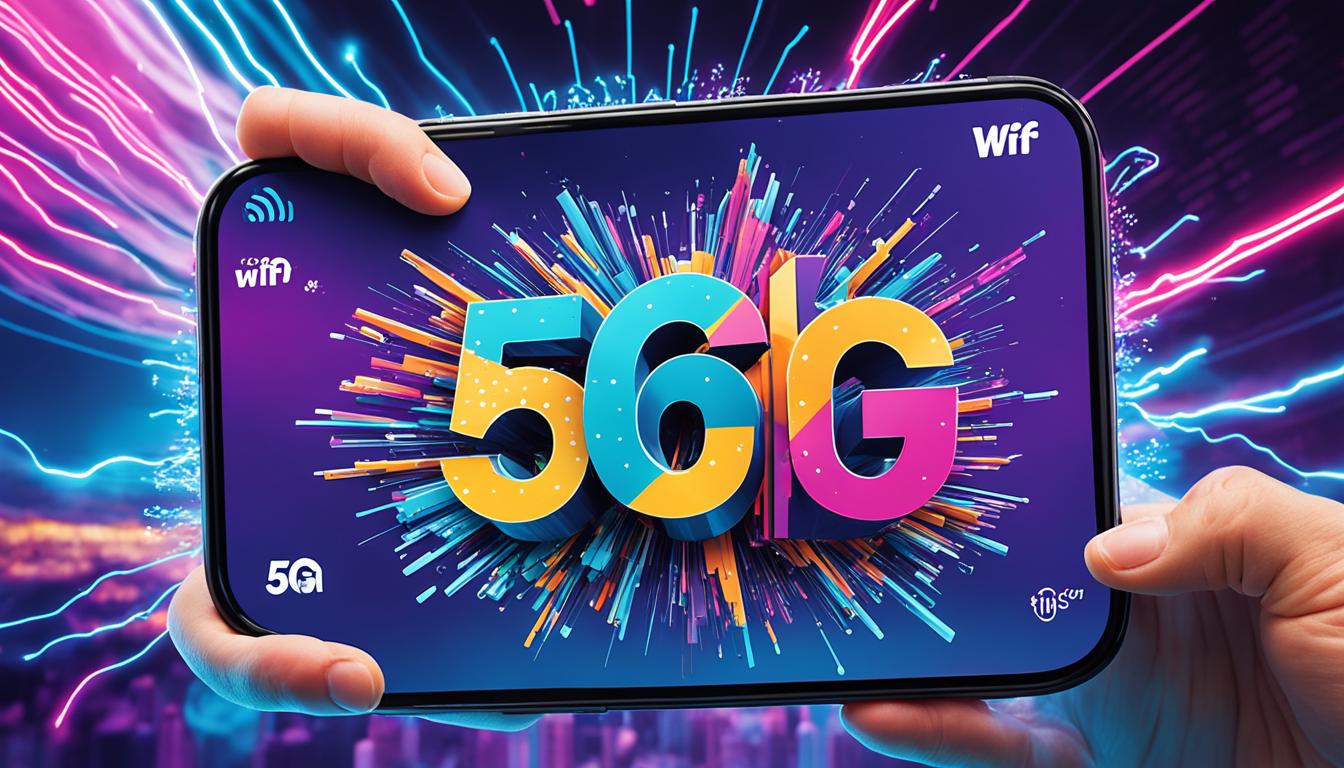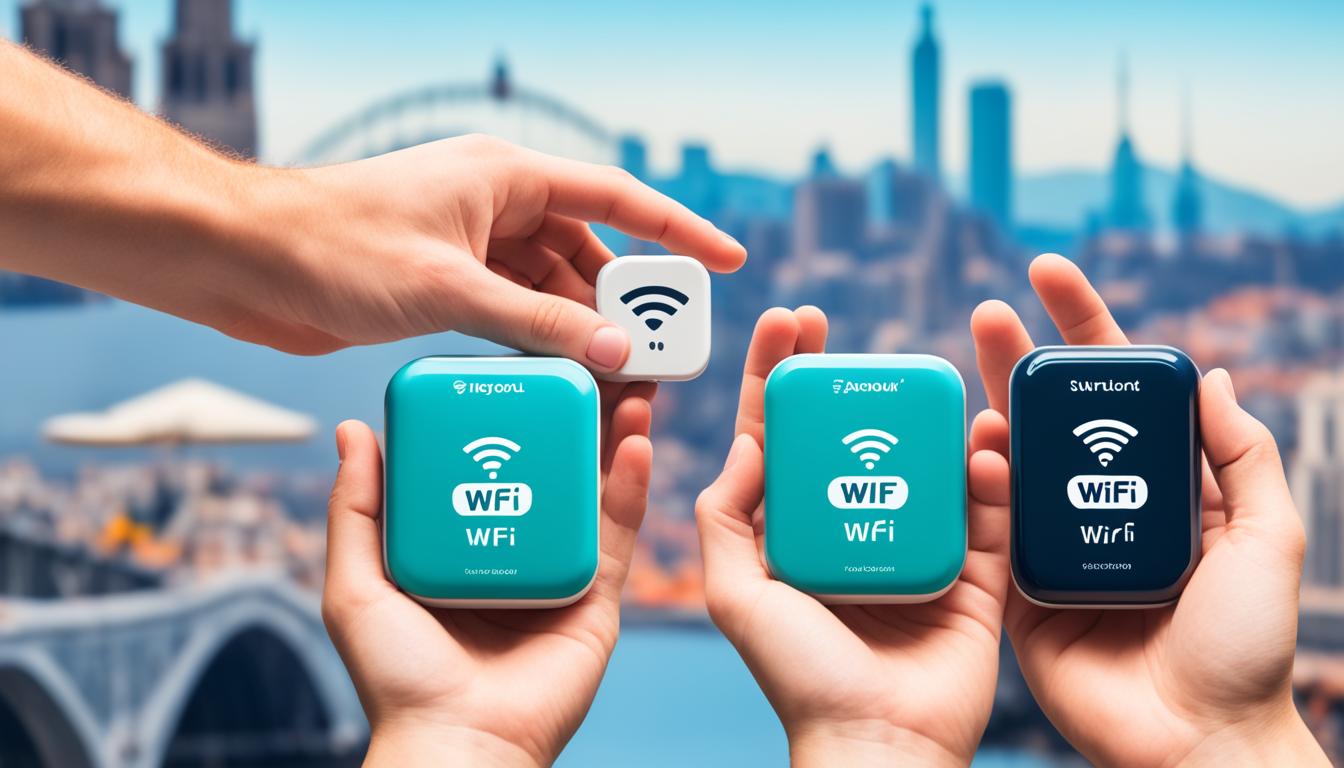The way we access and experience cultural sites and artifacts is undergoing a profound transformation, thanks to the advent of portable WiFi mobile hotspots. But have you ever wondered how these small devices are shaping the future of cultural preservation? How do they contribute to the accessibility and engagement of global culture? Let’s explore the incredible possibilities that portable WiFi mobile hotspots present for the preservation and immersive experience of our rich heritage.
Key Takeaways:
- Portable WiFi mobile hotspots provide fast and reliable internet connectivity for virtual tours and cultural preservation.
- With the use of digital twins, virtual replicas of heritage sites and artifacts can be accessed and studied.
- 5G technology enhances the capabilities of mobile hotspots, offering lightning-fast speeds and expanded coverage.
- The evolution of roaming charges has made staying connected while traveling more affordable and convenient.
- The seamless integration of portable WiFi mobile hotspots, digital twins, and 5G technology is shaping the future of cultural preservation and accessibility.
The Role of Digital Twins in Cultural Heritage Preservation
Digital twins play a crucial role in the preservation of cultural heritage. These virtual replicas of physical objects and environments enable researchers, scholars, and the public to interact with and study heritage sites and artifacts that may have been damaged or lost. Digital twins can be created using a combination of 3D scanning, photogrammetry, and advanced rendering technologies.
By utilizing precise 3D scanning techniques, digital twins provide a detailed and accurate representation of historical sites and artifacts. Photogrammetry further enhances the virtual experience by capturing multiple images from different angles and reconstructing them into a cohesive 3D model. Advanced rendering technologies then bring the digital twin to life, creating a visually immersive and interactive environment.
With digital twins, users can explore heritage sites and artifacts in a virtual space, allowing for educational and curatorial purposes. They provide a unique opportunity to study delicate or inaccessible areas, as well as objects that may be too fragile to handle. The virtual environment can be manipulated, allowing for detailed examination and analysis of the artifacts, enhancing research and understanding.
Furthermore, digital twins have the potential to monitor and track the condition of heritage sites and artifacts in real time. Sensors embedded within the virtual environment can provide valuable data on temperature, humidity, and other environmental factors that may affect preservation. This information enables curators and conservationists to identify potential risks and take preventive measures to ensure the long-term feasibility of cultural heritage.
Stay Connected Anywhere with Our Favorite Portable WiFi Mobile Hotspot!
Experience seamless connectivity on-the-go with our portable WiFi mobile hotspot. Stay connected with high-speed internet wherever you are.
Stay connected on-the-go! Get your portable WiFi mobile hotspot today and enjoy reliable internet wherever you travel.
Advantages of Digital Twins in Cultural Heritage Preservation:
- Virtual interaction and study of damaged or lost heritage sites and artifacts
- Enhanced educational and curatorial experiences
- Ability to examine and analyze delicate or inaccessible objects
- Real-time monitoring of environmental conditions for preventive measures
The development of standardized software, hardware, and interoperability is essential for the widespread adoption and reproducibility of digital twins in cultural heritage preservation. Creating a unified platform that can support various types of digital twins and facilitate collaboration among researchers, curators, and conservationists will be instrumental in ensuring the continued preservation and accessibility of global cultural heritage.

The Impact of 5G Technology on Mobile Hotspots
The advent of 5G technology has revolutionized the capabilities of mobile hotspots, enhancing their performance and expanding their reach. With lightning-fast internet speeds and low latency, 5G has become the go-to technology for seamless connectivity while using portable WiFi hotspots. Whether you’re streaming high-definition content, attending virtual meetings, or downloading large files, 5G ensures a smooth and lag-free experience.
One of the significant advantages of 5G-powered mobile hotspots is their improved coverage and connectivity, even in remote areas. The extensive network coverage empowers users to stay connected no matter where they are, ensuring access to vital information and cultural experiences. This extended reach of portable WiFi hotspots fueled by 5G technology has played a crucial role in making cultural preservation efforts more accessible and inclusive.
By integrating 5G connectivity with portable WiFi hotspots, users can engage in virtual tours and contribute to the preservation of global culture from anywhere in the world. The seamless and reliable internet connection provided by 5G technology allows individuals to explore cultural heritage sites, participate in virtual events, and immerse themselves in educational experiences without interruptions or buffering.

Additionally, 5G-enabled mobile hotspots ensure stable internet connectivity, empowering individuals to actively participate in the preservation of cultural heritage. Whether it’s sharing stories, uploading media, or exchanging ideas, these portable devices fueled by 5G technology enable the global community to collaborate and contribute to the safeguarding of our shared history and traditions.
In summary, 5G technology has had a significant impact on mobile hotspots, enhancing their capabilities and extending their reach. With lightning-fast speeds, improved coverage, and stable connectivity, 5G-powered portable WiFi hotspots enable users to engage in cultural preservation efforts and access global culture from any location. As 5G technology continues to evolve, the future holds even more exciting possibilities for the intersection of mobile hotspots and cultural preservation.
The Evolution of Roaming Charges and Connectivity
The evolution of roaming charges has transformed the way travelers stay connected while abroad. Historically, international roaming charges were a significant concern, leading to bill shock and limited access to data and communication services. However, regulatory interventions, the introduction of roaming packages, and the rise of Wi-Fi alternatives have mitigated these challenges.
Travelers now have access to affordable roaming packages, global SIM cards, and Wi-Fi networks, reducing or eliminating exorbitant roaming charges. This enhanced connectivity ensures seamless communication, convenient travel, and increased customer satisfaction.
While complete elimination of roaming charges is not yet a reality, advancements in technology, such as the implementation of 5G networks and continued regulatory action, are paving the way for improved access and affordability in the future.
| Advancements in Roaming Charges and Connectivity | Benefits |
|---|---|
| Introduction of roaming packages | Lower roaming charges and improved access |
| Global SIM cards | Convenience and cost-effectiveness |
| Wi-Fi alternatives | Reduced reliance on cellular networks and cost savings |
| Advancements in 5G technology | Lightning-fast speeds and expanded coverage |
With ongoing efforts to improve connectivity and reduce roaming charges, travelers can look forward to a future where staying connected abroad is hassle-free and affordable.
Conclusion
Portable WiFi mobile hotspots, combined with virtual reality, digital twins, and 5G technology, are revolutionizing cultural preservation and access to global culture. These devices provide fast and reliable internet connectivity, enabling users to engage in virtual tours, virtual events, and virtual learning experiences.
Digital twins play a crucial role in preserving cultural heritage by creating virtual replicas of sites and artifacts, allowing for immersive experiences and educational purposes. With digital twins, individuals can explore historically significant locations and study artifacts that may have been damaged or lost, ensuring that the world’s cultural treasures are accessible to all.
The introduction of 5G technology enhances the capabilities of portable WiFi hotspots, providing lightning-fast speeds, expanded coverage, and improved connectivity. This allows users to seamlessly stream high-definition content, attend virtual meetings, and download large files while on the go.
As roaming charges evolve and become more affordable, travelers can now stay connected without worrying about excessive fees. With the integration of portable WiFi hotspots, digital twins, and 5G technology, cultural preservation and global connectivity are poised for a future where global culture can be accessed and shared by all, ensuring that our rich heritage continues to be cherished and celebrated for generations to come.

